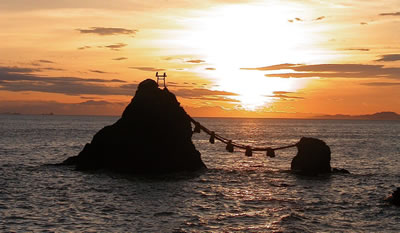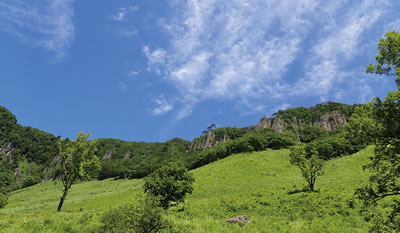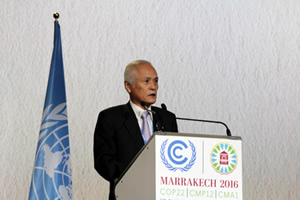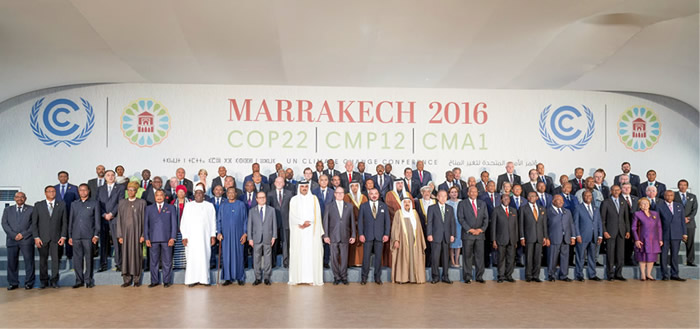Current Topics
"Visit! National Park" project
Make national parks the destinations that tourists all over the world desire to visit
Ministry of the Environment is currently promoting the "Visit! National Park" project, a branding campaign to turn national parks of Japan into world-level national parks based on the "Tourism Vision to Support the Future of Japan," formulated by the Japanese government in March last year, and is intended to increase the annual number of inbound tourists who visit national parks from 4.3 million in 2015 to 10 million in 2020.
In the last and this issues, we would like to introduce the charms of 4 of the 8 national parks as pioneering models of the project.
Ise-Shima National Park
Theme: Ise-Jingu (Shrine), a site where a long, splendid, multifaceted history unfolds; Satoyama and Satoumi, a land of enrichment interweaved with the workings of people and nature.

Ise-Shima National Park: Sunrise caught between the Meoto Iwa Rocks (Wedded Rocks) in Futami
Ise-Shima National Park, designated as a National Park in November 1946, celebrated the 70th anniversary of its designation last year.
This National Park lies on the Shima Peninsula, which is set in the center of Mie Prefecture, and its surrounding areas, occupying a vast area of nearly 60,000 hectares. Over 96% of the park land is under private ownership with a large residential population, and a great charm of this park, therefore, is its proximity to the local community, which makes it possible for visitors to be exposed to the lifestyle, history, culture and customs that are unique to the community.
Ise-Jingu, a shrine complex composed of about 125 shrines including the Inner and Outer Shrines (Naiku and Geku), is located within the National Park and attracts nearly 10 million visitors annually from home and abroad.
On the coast of the Shima Peninsula, the land went through repeated sedimentation and prominence to form a complex landform of a ria coastline abounding in capes and inlets, which were created by seawater entering the areas that were previously rivers and valleys. Since ancient times, Shima has been known traditionally as one of the Miketsu-Kuni (the land of divine offerings), a region which offers the bounty of the land and the sea to Ise-Jingu, and the region's rich marine resources and Ama (female divers) have long supported such a regional tradition.
Daisen-Oki National Park
Theme: Mountains and Islands where Myths Interlace; a series of volcanoes where the gods reside, and islands that breathe with ancient memories.

Daisen-Oki National Park: Mt.Senjo
Designated in February 1936, Daisen-Oki National Park marked its 80th anniversary last year.
Daisen-Oki National Park is a park marked with numerous variations, encompassing the following four areas: the mountainous area which includes Mt. Daisen, the highest peak in the Chugoku region, Mt. Hiruzen, Mt. Kenashi and Mt. Senjo; the coastal area in the Shimane Peninsula; Mt. Sanbe and its surrounding area and the Oki Islands.
Mt. Daisen, the center of a mountainous area, is also known as "Hoki Fuji," meaning Tottori's Mt. Fuji, and has been worshipped as a sacred mountain since old times. Daisen-Ji (Temple) was founded in 718 during the Nara era and was crowded with many worshippers over the Edo era. As the Temple will celebrate the 1300th anniversary of its opening next year (2018), the entire local community is working together to organize the scheduled this celebration.
Both the Okinoshima Islands and the Shimane Peninsula provide the setting for some Japanese mythological tales such as "Kunibiki Shinwa (Land-pulling myth)." The Shimane Peninsula in particular served as the center of the ancient Izumo culture and is dotted with a number of historical sites and landmarks that are associated with the myths, including Izumo-Taisha (Shrine), Hinomisaki-Jinja (Shrine) and Kakanokukedo (wave-eroded cave mouths).
The Oki Islands alternately had a land connection to the Shimane Peninsula and got separated to form isolated islands repeatedly due to changes in sea levels. The geohistory has resulted in the creation of the precious geologic resources and the unique ecosystem, which then lead to the designation of the Islands as a UNESCO Global Geopark.
Further step forward for decarbonization of the world
After the historical adoption of the Paris Agreement in 2015, the international society moves on to its implementation stage.

Statement by Minister Yamamoto at the COP22 high level session
The 22nd session of the Conference of the Parties to the United Nations Framework Convention on Climate Change (COP22) was held at Marrakech, Morocco from 7 to 18 November in 2016. The 1st session of the Conference of the Parties serving as the Meeting of the Parties to the Paris Agreement (CMA1) was also held in conjunction with the COP22, corresponding to the Agreement having taken into effect on 4 November.
During the COP22, the US presidency election was conducted and all of the attentions were dragged to the direction of the climate change policy of the newly elected president. The heads of government and ministers from each country clearly declared their will to unite in implementation of the Agreement steadily and this trend was irreversible. All parties agreed at the COP22 that the work for developing guidelines for the Agreement will be completed at the latest 2018. It was great progress that the work programme was concluded under the participation of all the UNFCCC parties.
Effective support under the multilateral cooperation is also necessary for developing countries in order to implement their nationally determined contribution (NDC) steadily. For their support, Minister of the Environment Yamamoto announced "Japan's Assistance Initiatives to address Climate Change", which includes the promotion of Joint Crediting Mechanism (JCM) and establishment of "Asia-Pacific Adaptation Information Platform". Japan will continue to undertake its support activities based on the initiatives in accordance with various needs of developing countries, while taking advantage of Japan's strengths.




